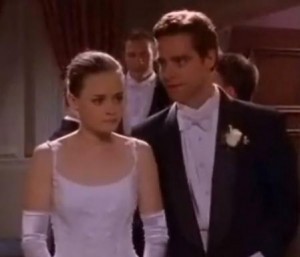How “Women’s Television” Does Money

Sady Doyle has written a piece in the Baffler about women — specifically “the Gilmore Girls” — and wealth on television. Gender, money, pop culture: is it any wonder I nearly whooped for joy?
Her point is that prestige, male-oriented shows like Breaking Bad and Mad Men revel in the dark side of the American dream. Female-oriented shows, though, are much more skittish about the subject of class. She cites “the Gilmore Girls,” which we’ve discussed on this site before, as a prime example.
Rory Gilmore is neither rich nor poor. She is both.
Rory’s super-wealthy grandparents are uptight, yes, but they also give her anything she wants. Rory’s single working mother’s lack of income never holds Rory back. Over the course of Gilmore Girls, we watch Rory rocket up the class ladder: there’s a private school scholarship, a well-connected relative who gets her into Yale, and a wealthy (terrible) boyfriend. We can’t hold anything against Rory because her lower-middle-class roots are pure.. It’s a classic Cinderella story. The signifiers of class are there, but the actual problems are absent; the poor girl becomes a princess, overnight, and with no effort.
Rory’s likeability, then, is a cop-out because, as Doyle claims, “Everyone wants to become rich, but no one actually likes real-life rich people. (We instinctively prefer them as villains.)” Hm. I could introduce her to some commenters who might disagree.
One point that Doyle misses, though, is that “Gilmore Girls,” like the other lady-type shows she mentions, is a sitcom comedy/dramedy, while Breaking Bad, Hannibal, and so on are generally hour-long dramas. Dramas are darker and more serious. Like, by definition.
I don’t mean to say that sitcoms (and their ilk) can’t do class well: as we recently established, comedies from “All in the Family” to “Roseanne” used to be one of the main ways we processed ideas about class as a country, and we’ve lost a lot culturally in our shift away from that paradigm. Speaking of which, how does one write a story about women and wealth on TV and not mention “Roseanne”? Or HBO’s recent reboot of “Mildred Pierce,” for that matter?
The real issue is that women don’t get to lead serious, gritty dramas, and dramas are where the action is. Sure, in some prestige cable shows, like The Sopranos and Six Feet Under, they shared some of the top billing slots. Largely, though, we seem to be much more comfortable with women and wealth if the subjects are dealt with in light half-hour packages, and we can put them away when we’re done with them without having the aftereffects linger to spoil our appetites.
Maybe there’s something about a real-life woman coping with real-life poverty that’s too depressing for television — or at least so the executive thinking goes. Like putting an ugly woman at the center of a show. Who wants to see that? Give us Kerry Washington, please! Ladies who are easy on the eyes and problems that are easy to solve.
Again, though, “Roseanne.”
By the end of its first season, Roseanne was the second most popular show on television. By season two, it hit number one, beating The Cosby Show by 200,000 viewers. The ABC blue collar sitcom would stay in the top-10 until season eight, when it dropped to #16.
What a revelation that show was, and why can’t we have something like it again? We have roughly 3,000 cable channels to choose from now, and networks probably have twice as many monkeys on typewriters banging out what they hope will be the next hit. Surely one of them could come up with something that has real, interesting things to say about people trying to make it in America.
*Edits post-publication in bold
Support The Billfold
The Billfold continues to exist thanks to support from our readers. Help us continue to do our work by making a monthly pledge on Patreon or a one-time-only contribution through PayPal.
Comments